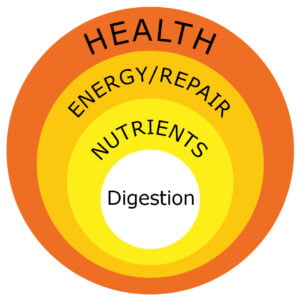You might not be aware of how the foods you eat and digestion may be affecting your quality of life!

On the other hand, if you are not eating nutritious foods you are now supplying the body with toxins and chemicals. The most common and probable causes are diet, alcohol, and stress. Diet is the biggest challenge, especially a diet of processed foods high in sugar, chemicals, and artificial ingredients and low in fiber, nutrients, and antioxidants.
The beauty of the human body is that you can easily keep this ripple effect as a positive process. Deliver the nutrients to the cell, clear the toxicity, and allow the healing. That is the good news. Removing the offending agents is the first priority. Changing and adhering to a clean, nutrient-dense, regenerative diet is mandatory. The second step is supporting the digestive process and the beneficial bacteria. You must ensure optimal and complete digestion of the healthiest of foods.
This second step is what most people fail to do. They begin supplementing with nutrients they are deficient in, not stopping to realize why they are deficient or even if they will fully digest the nutritional supplements. This second step of supporting the digestive process is key.
Making a Commitment to Thrive in 63
Why 63 days? Research has shown it takes at least three 21-day cycles to make a permanent, transformational change. This science is called psychoneuroimmunology, the study of how the emotions, the nervous system, and the immune system affect each other. That means the role our psychological processes have on our physiological processes – how our behaviors, habits, thoughts, and emotions impact our physical and chemical health.
- In the first 21-day period, the body will recognize you are making changes.
- In the second 21-day period, the body will begin to balance, adjust, and accept the changes.
- In the third 21-day period, the body undergoes the transformation phase.
The 63 days gives the mind an adequate length of time to adjust to the change in a positive and beneficial manner. These 21-day segments of response to change are an established regimen among health care practitioners. Although you may feel better immediately when you begin a new program, there is a period of adjustment while your body seeks a new comfort zone. Response is heightened in the second period. Finally, the third phase has definitely improved for the better.

Are you thinking of beginning the Thrive in 63 program? We are excited for you. The program you are considering will change your life. The Thrive in 63 program was named after a 63-day clinical study using enzyme and diet modifications. This is an excellent place for you to begin your journey!
- Believe you can be well again. Your thoughts have the power to heal. Give yourself permission to rest and be well.
- Take responsibility. Good health is not an unobtainable privilege meant to be savored only by the fortunate. It is a right that should be enjoyed by anyone who is willing to take the time to learn how to take care of his or her own body. Our lifestyle and environment account for 90-95% of good health. It starts with you.
- Get intentional. Make a 21/21/21 Commitment. This program is broken down into three 21-day periods. You will be asked to make some changes, set goals for yourself, and become disciplined about your follow through. We promise you will feel the difference! The first 21 days, the body only recognizes you’re trying to make a change. The next 21 days, you begin to internalize this change and you will begin to feel a difference. It takes the final 21 days of this program for transformation to take place. You can do this – just start with the first 21 days.
- Accept guidance. You will be supported along this journey to wellness. Your practitioner and support team have guided others just like you to achieve your goals. Their dedication and education can provide you with insight to any challenges you may face. They want nothing more than you to succeed. You can trust their guidance and the program.
- Be open to learning. As we stated before, it is your responsibility to learn how best to take care of your body. There will be lots of opportunity to learn from your team of providers as well as from others in the program. Ask questions, learn valuable lessons on how to stay well and share the wisdom you’ve learned with your friends and family.
- Practice mindfulness. The program you are about to begin is really about simplifying the way we live life. We begin by slowing down and focusing on the foods we eat. What happens when you slow down? Everything else slows down and now we can focus on healing. Breathe deeply and slowly choose foods that are non-processed and organic and drink more water. Simple.
- Journal your progress. You will be asked to keep a daily journal of foods eaten, beverages consumed, and supplements taken during these 63 days. You will be asked to bring your journal to all your appointments so you can address what works and what challenges you. It is important to document your progress. The practice of listening to what your body is telling you is a key element. Your practitioner will use this information to assist you to make the changes you need to make.
Menu Instructions
This program will provide you with a 63-day meal plan, food lists, recipes, and a food and supplement journal. The meal plan can be followed exactly, but does not have to be. You may swap out any food item for another food item in the same category. For example, if you do not like Brussels sprouts you may swap them for broccoli. If the recipe is too complicated, simply cook the food item in your favorite way.
This is neither a calorie count nor a calorie restrictive diet. You may eat as much of any allowed food as you want to. We encourage you to plan and prepare adequate portions, be mindful and present while eating, and pay attention to your body’s satiety cues.
We encourage you to be creative and make it your own, and we want what you eat to be realistic for you and your lifestyle. However, there are some general rules you must follow. Your body will respond in kind and you will be amazed at how wonderful you feel.
We recommend and encourage you choose as often as possible:
- All fresh fruits and vegetables – locally grown or organic (frozen is acceptable)
- All beef, poultry, seafood, and pork – should be wild caught seafood and game, cage-free poultry, and beef that has been grass fed, without the use of growth hormones or antibiotics
- Healthy fats from nuts, seeds, olive, avocado, and coconut are encouraged – purchase oils that are minimally processed, cold pressed, or expeller pressed (grass fed butter and ghee are also acceptable fats in moderation)
- Water, fresh juice, green tea
- The majority of foods should be eaten fresh, raw, or as close to their natural state as possible
- Locally grown, organic, and non-GMO foods
The basic meal plan includes a protein + fruit/vegetable + a fat for each meal. It is important to note this is not a weight loss program. There is no portion control. We simply ask that you pay attention to your body and eat the allowed foods when hungry.
We also ask that you AVOID the following:
- All grains – wheat, barley, rye, oats, rice, quinoa, amaranth, buckwheat, etc
- Legumes – peanuts, kidney beans, black beans, red beans, navy beans, garbonzo beans, lentils, lima beans, peas, etc
- Processed foods – includes most foods that are pre-packaged, boxed, bagged, microwavable, etc
- All commercial dairy – milk, cheese, yogurt, ice cream, sour cream, etc (grass fed butter and ghee are allowed if not on dairy restriction)
- All sugar, high fructose corn syrup and/or artificial sweeteners (molasses and local honey are acceptable)
- Alcohol, sodas, caffeine
- Other – corn
What if I do not or cannot cook and I eat out often?
We realize planning and preparing your own meals can be overwhelming for someone who has never cooked before. It is important to remember your “commitment” you made to the program. You will see that many of the meals and recipes are very simple and easy to follow. We encourage you to try your hand at cooking, as this is a big part of taking responsibility for your choices and improving your health.
There are healthy alternatives for those times when eating out is the only option. Look for restaurants in your area who promote the use of organic, locally grown, and whole food menu items. Whole Foods Markets is an example of a grocery chain that provides healthy buffet items, and you can look for similar stores in your area. Many cities now have chef services where a chef will prepare food for you in your kitchen or deliver it.
Also, once you become familiar with the menus, you will see many of the selections will be available at many restaurants. For example, Garden Salad with Grilled Chicken, Salmon with Grilled Vegetables, or Bun-less Burgers are menu items readily available in virtually any restaurant.
The following is a list of healthy foods to help you when shopping or eating out:
Fruits
- Apples
- Apricots
- Bananas
- Blackberries
- Blueberries
- Cantaloupe
- Cherries
- Cranberries
- Dates
- Dragon Fruit
- Durian
- Figs
- Grapes
- Honeydew
- Kiwi
- Lemon
- Lime
- Mango
- Oranges
- Papaya
- Peaches
- Pears
- Pineapple
- Plantains
- Plums
- Raspberries
- Strawberries
- Watermelon
Vegetables (starchy)
- Beets
- Carrots
- Jicama
- Parsnips
- Plantains
- Pumpkin
- Snow Peas
- Sweet Potatoes
- Taro
- Turnips
- Winter Squash (Pumpkin, Acorn, Butternut)
- White Potatoes
- Yams
Vegetables (non-starchy)
- Asparagus
- Artichoke
- Arugula
- Bamboo Shoots
- Bell Peppers (Red, Green, Yellow, Orange)
- Bok Choy
- Broccoli
- Brussels Sprouts
- Cabbage
- Cauliflower
- Celery
- Chard
- Chives
- Cilantro
- Cucumbers
- Eggplant
- Endive
- Fennel
- Garlic
- Greens (Collard, Turnip, Mustard, Chard)
- Green Beans
- Jalapeños (and other hot peppers)
- Kale
- Kohlrabi
- Leeks
- Lettuce (except Iceberg)
- Mushrooms (Portobello, Shiitake, Oyster, Button)
- Okra
- Onions (Red, Purple, Green, White, Yellow)
- Parsley
- Radicchio
- Radishes
- Rutabaga
- Scallions
- Seaweed (Dulse, Nori, Hijiki, Kombu)
- Spinach
- Spring mix
- Sprouts (all varieties)
- String Beans
- Tomatoes
- Water Chestnut
- Watercress
- Zucchini
Meats / Proteins
- Bacon
- Beef
- Buffalo
- Chicken
- Crab**
- Deer
- Duck
- Eggs**
- Fish**
- Lamb
- Lobster**
- Pork
- Protein Powder (Beef, Cod, Pea)
- Tuna**
- Turkey
- Shrimp**
Nuts / Nut Butters**
- Almonds
- Almond butter
- Brazil Nuts
- Cashews
- Coconut
- Hazelnuts
- Macadamia
- Nut Flours
- Pecans
- Pine Nuts
- Pistachios
- Walnuts
Seeds
- Chia
- Flax
- Hemp
- Pumpkin
- Sesame
- Sunflower
Oils / Fats
- Avocado
- Avocado oil
- Butter (grass fed)
- Coconut oil (organic)
- Ghee
- Mayonnaise (homemade, Chosen Foods®, Primal Kitchen®)
- Olives
- Olive oil
Condiments, Spices, Seasonings
- Basil
- Bay leaves
- Black Pepper
- Cardamom
- Capers
- Cayenne
- Chilies
- Chili powder
- Cilantro
- Cinnamon
- Coriander
- Cumin
- Curry Powder
- Dill Weed
- Fennel
- Ginger
- Lemon
- Lemon pepper
- Lime
- Mayonnaise (homemade, Chosen Foods®, Primal Kitchen®)
- Mint leaves
- Mustard
- Nutmeg
- Oregano
- Paprika
- Pickles
- Ras el hanout (spice blend)
- Rosemary
- Sage
- Stock (Chicken, Beef, Vegetable, or Bone Broth)
- Tamari
- Tarragon
- Thyme
- Turmeric
- Vanilla
- Vinegar (Apple Cider, Balsamic)
- Worcestershire sauce
Beverages
- Almond milk
- Coconut milk
- Cashew milk
- Fresh juices (limit)
- Hemp milk
- Bone broth
- Herbal teas
- Matcha
- Water
Miscellaneous
- Arrowroot powder
- Coconut aminos
- EPIC® beef jerky
- RX Bars®
- Honey
- Molasses
- Plantain chips
- Salsa (organic)
- Thunderbird® bar
**NOTE: The eight most common allergy foods are dairy, eggs, fish, shellfish, tree nuts, peanuts, soy, and wheat.
As often as possible, choose locally grown, non-GMO, pesticide / herbicide free, antibiotic free, hormone free, grass fed, free range, wild animals.
- How to Pick Your Probiotic - October 30, 2024
- Do Probiotics Require Refrigeration? - August 14, 2024
- Five Pillars of Health - October 18, 2023

Is yucca/tapioca allowed as starchy vegetable?
yes, yucca and tapioca are allowed on both the Thrive for Kids regular Thrive in 63 programs.